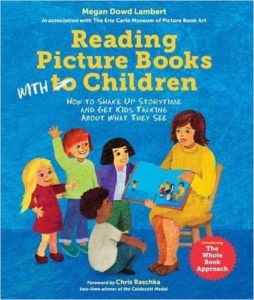Reading Picture Books with Children
 Reading Picture Books with Children: How to Shake Up Storytime and Get Kids Talking About What They See, by Megan Dowd Lambert. Published by Charlesbridge in 2015. 176 pp.
Reading Picture Books with Children: How to Shake Up Storytime and Get Kids Talking About What They See, by Megan Dowd Lambert. Published by Charlesbridge in 2015. 176 pp.
Part of the appeal of Reading Picture Books with Children by Megan Dowd Lambert is its celebration of the “thingness” of the book, or, put another way, of the book as an object that engages the senses. She begins this deep dive into the book object by calling out aspects of the book with notes in a handwritten-like script, pointing out the gutter, the smyth-sewn binding, the metatextual content, etc. All of this information is just a prelude to a revelation of Lambert’s Whole Book Approach from its inception, to its early workshops, to its inclusion in curricula up to and including the creation of this book. The cover is blatant—you should read picture books with children, not to them. There’s a difference and Lambert tells you how to explore and implement that difference to communicate the Whole Book to the whole child.
It’s not an overstatement to say that a close reading and doing of the strategies outlined in this book will change the way you use picture books. Lambert’s detailed analysis examines every aspect and step of sharing a book and does this in a way that seems not only possible but imperative. The dustjacket, the cover, the endpapers, typography, etc., can all be invitations to not only engage with the book but to listen to children communicate their perceptions and observations, making the experience richer for all.
Yet the Whole Book Approach is not about dissection, it’s about a fuller understanding. Lambert talks about devoting time and space to nurturing visual intelligence. A book about picture books must have ample illustrations and, while more pictures would have been welcome, the reader is given enough visual information to convey the point. A picture of a flamingo also looks like the side of an elephant’s head, suggests a particularly visually astute child. Lambert doesn’t shy away from often noting observations made by children that had eluded her for hundreds (even thousands, she once suggests) of readings.
If nothing else, Lambert notes that the Whole Book Approach prevents the picture-book sharer from lapsing into crowd control mode. When you take the time to really look and experience all the aspects of a picture book, all the participants become wholly engaged and isn’t that the endgame everyone wants? And if it has beautiful endpapers that provide clues to the story, all the better.
